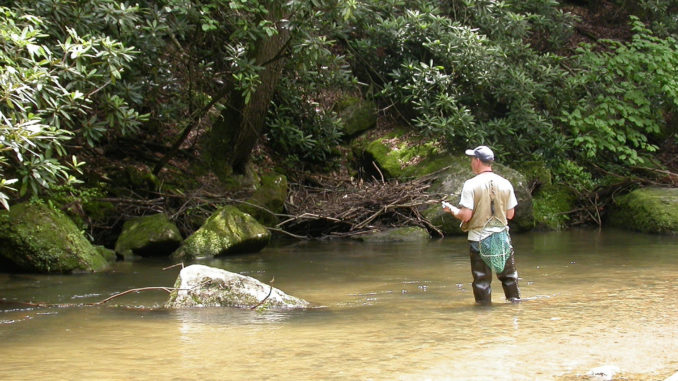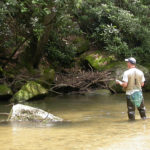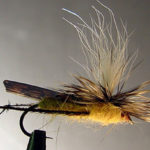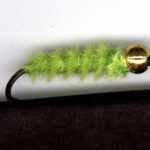
Trout will be on guard for ants, beetles, et al
Summer is the season for bugs: grasshoppers, ants, crickets, inchworms and beetles. Just about any insect that crawls, flies or hops is prime fare for trout. On mountain streams, hatches are minimal during the hot months, so trout depend heavily on insects that fall into the water rather than insects that hatch in the water.
You still have some hatches of stoneflies, midges, Caddis, Cahills and the ubiquitous Blue-Winged Olive, but when it’s a choice between a snack and a meal, trout prefer the big bites.
Terrestrials usually begin showing up in late May and June, and these insects fall or get blown into streams and become a major part of a trout’s diet until the first freeze in late fall either kills them off or sends them scurrying underground to await another season.
Since terrestrials usually are found in trees, bushes, and grass along edges of streams, the most-effective way to fish is to cast close to stream banks where insects are more likely to fall or land in the water.
My personal preferences are hoppers and inchworms. I’ve caught more trout on those two patterns than any of the other terrestrials. I have caught trout with stomachs full of Japanese beetles, but I’ve had limited success with beetle and ant patterns. When I’m hankering for a trout dinner and don’t feel like working for it, I will fish hatchery-supported streams with live june bugs, and, without much effort, catch my dinner. On backcountry streams, I fish exclusively with a Jack Cabe Hopper and a bead-head inchworm. It’s a rare outing that I don’t catch trout.
The Jack Cabe Hopper is considered by many veteran mountain fly fishers as one of the best trout flies made. The Cabe Hopper was originated by the late Jack Cabe of Highlands, a renowned fly fisher and guide. Other good patterns are Joe’s Hopper, the Letort Hopper and Dave’s Hopper, which are usually easier to find than the Cabe Hopper.
Inchworms are excellent patterns because they work just about any place in a stream from pools to riffles. I prefer bead-head patterns because the fly tumbles more like a real inchworm, and the added weight gets the fly down into deeper water, an important factor when fishing in hot weather.
Yellow, brown or black Humpy patterns are good beetle imitations because of the flies’ bulbous bodies. Black ants tied either with foam or dubbing are good for late August and early September. If you see trout feeding under tree overhangs, and there’s no wind, the trout usually are feeding on beetles. If the wind is blowing, an ant pattern is recommended because ants are more likely to be blown into the water than beetles. Insects don’t just jump in the water, they either land there accidentally or they are blown in. Ant patterns are especially effective in flat water under low-hanging limbs. An effective fishing technique for ants and hoppers is to let the fly ride on the surface and give it an occasional twitch to make it appear like a live insect struggling in the water.
Carpenter ants are the most common ants found along stream banks. This fly is easy to tie. Use two black balls of dubbing separated by a midsection that has a few strands of peacock or pearl-colored Krystal Flash and a few turns of CDC fiber. The Krystal Flash draws attention to the ant, and the CDC fibers wave like the legs of an ant Summer fly fishing requires finesse because streams usually are low, and the trout are extremely wary. Fishing with terrestrials doesn’t require finesse. You can plop a terrestrial close to a bank where laurel leaves lap the water, and you’re almost guaranteed a strike. Unlike spring hatches, terrestrials come in all shapes and sizes, and trout don’t see them in great numbers since they randomly fall or land in the water. What a trout does see when a terrestrial plops into a stream is a big mouthful of protein, and more often than not, a big brown or rainbow trout will go out of its way to nab it.
Patterns such as the yellow Stimulator, the Tellico Nymph, Elk Hair Caddis, Tennessee Wulff and Yellerhammer are good summer flies. They don’t imitate any insect in particular, but they do resemble common terrestrials enough to fool trout.
The best streams to fish in the summer are backcountry streams that have plenty of cover to keep the water comfortably cool for trout to thrive. Fishing guides usually quit delayed-harvest streams as soon as the season changes to catch-and-keep rules. The majority of the stocked fish usually are caught in the first two weeks after the change in regulations. Many of the smaller delayed-harvest streams still offer good fishing through the summer.
For comfort’s sake, make sure you include bug spray on your trips. Trout eat many of the bugs of summer, but some mean ones that love to feed on people are still out there.







Be the first to comment